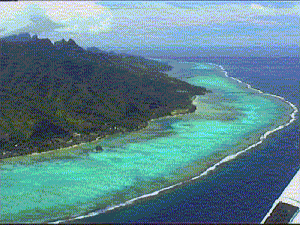|
|
Staff involved:Pete Mumby, Al Edwards, John Chisholm (Monaco), Serge Andrefouet (University South Florida), Jean Jaubert (Monaco)Funding:NERC, Prince Khaled bin Sultan bin Abdulaziz of Saudi Arabia, M.Y. Golden Shadow
Aerial view of Moorea, French Polynesia |
Coral bleaching in French Polynesia - causes & consequencesProjectThe 1998 ENSO event was the most severe ever recorded eliciting unprecedented coral bleaching world-wide. In some parts of French Polynesia, such as Rangiroa Atoll, coral mortality was severe with >99% loss of Pocillopora and 25% loss of Porites. However, bleaching did not occur in the Society Islands (Tahiti and Moorea). This project evaluates meteorological conditions which may have caused coral bleaching at island scales. Specifically, the relative roles of sea surface temperature, cloud cover, wind speed, and sun hours are being evaluated. The project also attempts to predict the recovery of coral populations at Rangiroa atoll (Tuamotu Archipelago). SignificanceTo examine the predictability of coral bleaching events at island scales based on coarse meteorological measurements. The project also casts doubt on the use of thermal thresholds for predicting bleaching events. References
|
